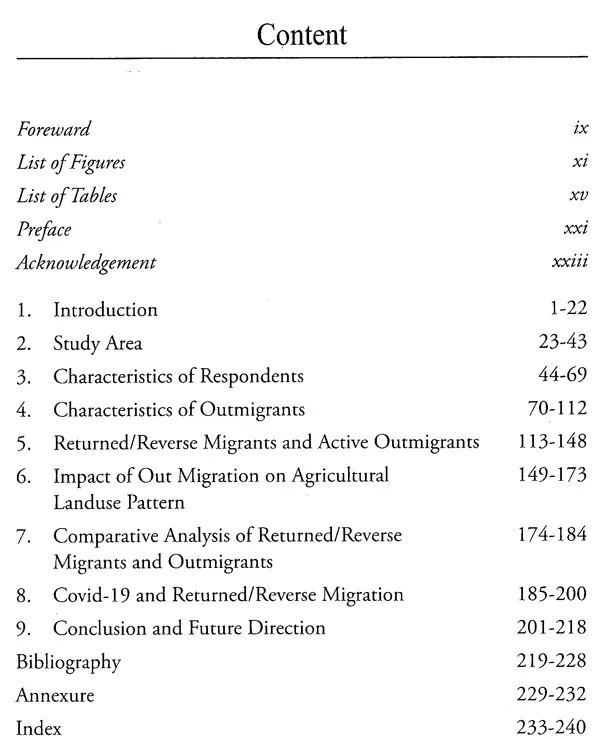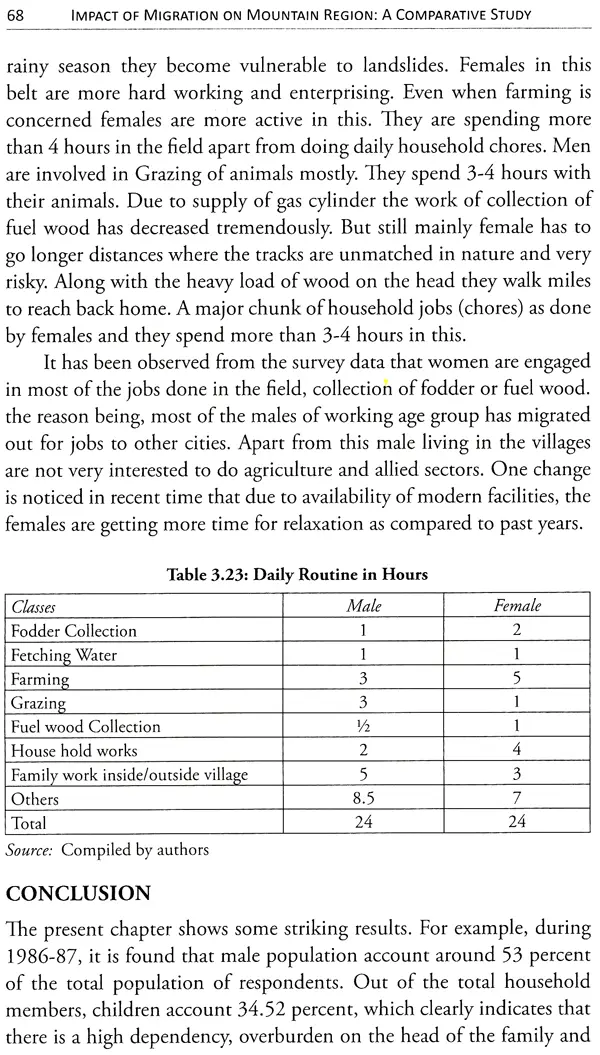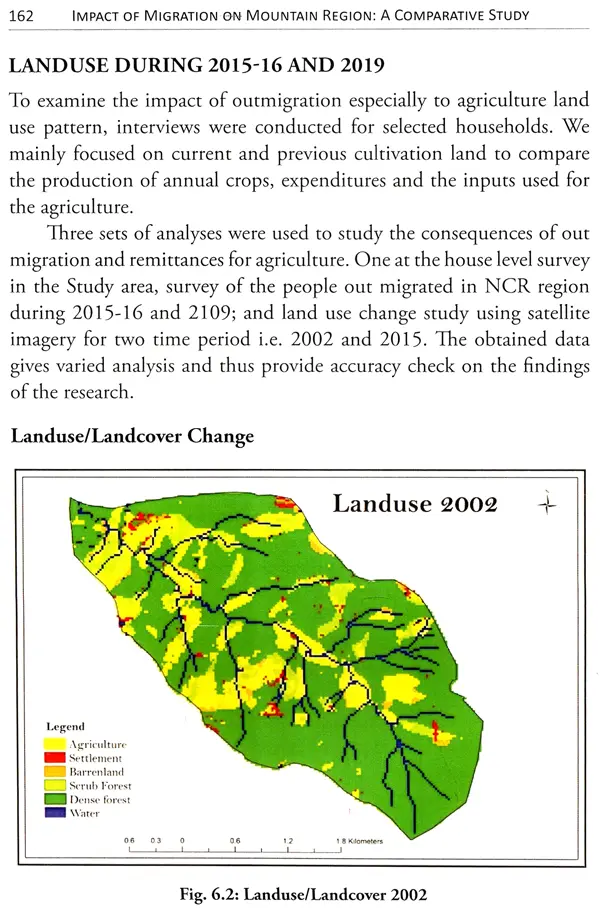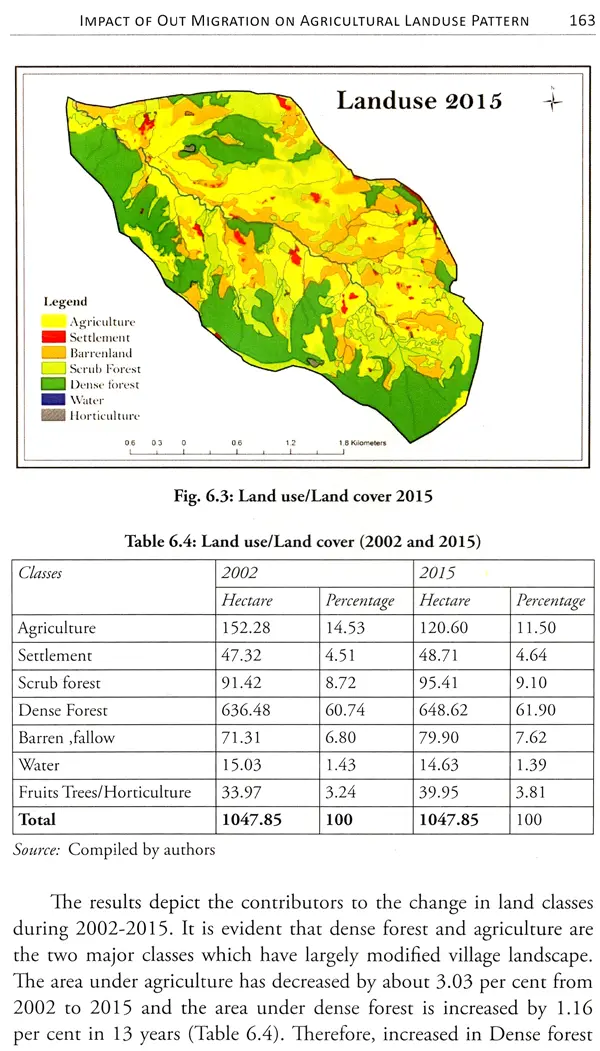
Impact of Migration On Mountain Region- A Comparative Study
Book Specification
| Item Code: | UAG371 |
| Author: | Various Authors |
| Publisher: | Research India Press |
| Language: | English |
| Edition: | 2022 |
| ISBN: | 9789351710615 |
| Pages: | 240 (Throughout Color Illustrations) |
| Cover: | HARDCOVER |
| Other Details | 9.50 X 6.50 inch |
| Weight | 590 gm |
Book Description
This book is a humble attempt to examine the characteristics of out-migrants and respondents and the impact of out-migration on agricultural land use pattern in Pauri Garhwal district during 1986-87 and in Lachi Gad of Pauri Garhwal during 2015-16 and 2019; characteristics of returned/reverse migrants and active outmigrants in 2020-21; and return/reverse migration during COVID-19.
The area is a promising one with serene ambience. The only coordination that is needed to activate is between the authorities and the stakeholders. If this can be channelized the mountain of Uttarakhand can become economically self-sustained and would regulate outmigration too. Another dimension is that if the outmigrants visit the area regularly and keep a continuous link with the native area and many of them return back to native area then it is not that harmful a process. Infact their continuing efforts of sharing knowledge about latest skills and development would boost the economy of the region insitu. They should be in connection with their roots and become instrumental in its holistic development.
Dr. Laishram Mirana Devi is an Assistance Professor in Shaheed Bhagat Singh Evening College (University of Delhi), India where she has been a faculty member since 2014. She received her Ph. D degree from the University of Jamia Millia Islamia, New Delhi on "Common Property Resources in Manipur: A Geographical Analysis" in 2013. Her research interest lies in the area of Natural Resources, Geospatial Techniques ranging from theory to design to implementation for different applications of Remote sensing and GIS. Much of her work focuses on gradual development and improving the understanding of the nature and the behaviour in which human relation with the natural world are practiced in day-to-day life. She has more than 20 research publication and E-lectures in different journals. Also visited different university and colleges on invited lectures.
Prof. Suresh Kumar Bandooni (b.1962) has been teaching in the Department of Geography, Shaheed Bhagat Singh Evening College (University of Delhi) since 1990. He has done his M. Phil and Ph.D from Department of Geography, Delhi School of Economics, University of Delhi. His specialization is Natural Resource Management, Himalayan system, Cartography and Sustainable Development. He aims to understand and work for Sustainable Rural Development in Uttarakhand. He has been the project Co -Director and Project Director for many years for Development and Research Centre for Sustainable Livelihood in Uttarakhand, a project sponsored by SEWA-THDC. He has also been the Project Co-investigator in many projects sponsored by DST and UGC. He has authored a book on Hill Management and editor of three books on Environmental Geo-hazards and Resource management. He has been the expert and editor of many dictionaries published by CSTT (Commission for Scientific and Technical Terminology, HRD, Govt. of India.). He has been the coordinator of UGC E PATHSHALA for content development and video recordings on Water Resource Management. He has also published many research papers and articles in many reputed journals and books. Presently he is the member of Advisory committee of Centre for Himalayan Studies, University of Delhi. He has also been an active trekker in the Himalaya. He is known for his experiential teachings.
It covers the very intriguing theme of Out-Migration, Active Out Migrants and Returned/Reverse Migrants from Pauri Garhwal district and its different areas from Uttarakhand in Himalaya and its impacts at length. The aspects of Out Migration, Returned/Reverse Migration and active Out Migrants are covered in detail. The book is completed in IX chapters. Each chapter leads to the next. For example chapter four and five deal with characteristics of Out Migrants and Returned/Reverse and Active Out Migrants Respectively.
The comparative analysis from 1986-87 to 2020-2021 has been critically analysed in chapters seven. The Respondents have been very cooperative in responding to the Questionnaire. In-fact a Chapter (8) on COVID 19 gives very strange results that many out migrants became Reverse Migrants and active Out Migrants due to the Pandemic. They have yet not gone back to the cities where they had migrated to due to variety of reasons from health risk to occupational uncertainty. The authors have given very suggestive ways for future direction for the sustainable development not only of study area but for the whole mountain areas of great Himalaya.
It is a very peculiar study worth going through word by word.
I congratulate the Authors on this extensive study and analysis and wish them well.
The present work is an attempt to examine the characteristics of out-migrants and respondents and impact of out-migration on agricultural landuse pattern in Pauri Garhwal district during 1985-86 and in Lachi Gad of Pauri Garhwal during 2015-16 and 2019, characteristics of returned/reverse and active outmigrants and reverse migration during Covid-19 in 2020-21. The study is based on primary and secondary data. Since, the secondary data does not provide complete information about outmigration and returned migrants and its related consequences, primary data have been collected in order to understand the characteristics and impact of out-migration and returned migration.
Like other Parts of the Himalaya, Uttarakhand Himalaya is also full of resources and has been attracting people from different parts of the world since hundreds of years. It is a store house for Primary, Secondary and Tertiary activities. Main resources in this region are forest and water. This place has immense potential for tourism.
**Contents and Sample Pages**

















